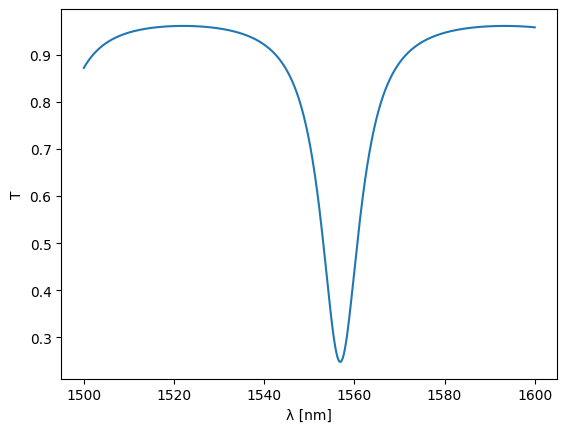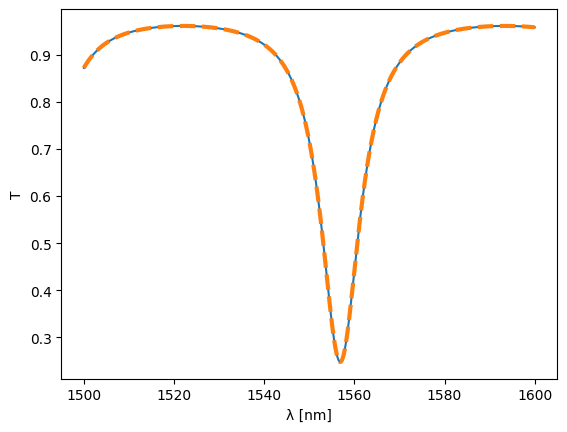Simulating an All-Pass Filter#
A simple comparison between an analytical evaluation of an all pass filter and using SAX.
import jax
import jax.numpy as jnp
import matplotlib.pyplot as plt
import sax
Schematic#
in0---out0
in1 out1
\ /
========
/ \
in0 <- in0 out0 -> out0
Simulation & Design Parameters#
loss = 0.1 # [dB/μm] (alpha) waveguide loss
neff = 2.34 # Effective index of the waveguides
ng = 3.4 # Group index of the waveguides
wl0 = 1.55 # [μm] the wavelength at which neff and ng are defined
ring_length = 10.0 # [μm] Length of the ring
coupling = 0.5 # [] coupling of the coupler
wl = jnp.linspace(1.5, 1.6, 1000) # [μm] Wavelengths to sweep over
Frequency Domain Analytically#
As a comparison, we first calculate the frequency domain response for the all-pass filter analytically:
\[\begin{align*}
o = \frac{t-10^{-\alpha L/20}\exp(2\pi j n_{\rm eff}(\lambda) L / \lambda)}{1-t10^{-\alpha L/20}\exp(2\pi j n_{\rm eff}(\lambda) L / \lambda)}s
\end{align*}\]
def all_pass_analytical():
"""Analytic Frequency Domain Response of an all pass filter"""
detected = jnp.zeros_like(wl)
transmission = 1 - coupling
neff_wl = (
neff + (wl0 - wl) * (ng - neff) / wl0
) # we expect a linear behavior with respect to wavelength
out = jnp.sqrt(transmission) - 10 ** (-loss * ring_length / 20.0) * jnp.exp(
2j * jnp.pi * neff_wl * ring_length / wl
)
out /= 1 - jnp.sqrt(transmission) * 10 ** (-loss * ring_length / 20.0) * jnp.exp(
2j * jnp.pi * neff_wl * ring_length / wl
)
detected = abs(out) ** 2
return detected
%time detected = all_pass_analytical() # non-jitted evaluation time
all_pass_analytical_jitted = jax.jit(all_pass_analytical)
%time detected = all_pass_analytical_jitted() # time to jit
%time detected = all_pass_analytical_jitted() # evaluation time after jitting
plt.plot(wl * 1e3, detected)
plt.xlabel("λ [nm]")
plt.ylabel("T")
plt.show()
CPU times: user 356 ms, sys: 12.2 ms, total: 368 ms
Wall time: 390 ms
CPU times: user 33.8 ms, sys: 2.2 ms, total: 36 ms
Wall time: 33.6 ms
CPU times: user 61 μs, sys: 0 ns, total: 61 μs
Wall time: 65.8 μs

Scatter Dictionaries#
all_pass_sax, _ = sax.circuit(
netlist={
"instances": {
"dc": {"component": "coupler", "settings": {"coupling": coupling}},
"top": {
"component": "straight",
"settings": {
"length": ring_length,
"loss": loss,
"neff": neff,
"ng": ng,
"wl0": wl0,
"wl": wl,
},
},
},
"connections": {
"dc,out1": "top,in0",
"top,out0": "dc,in1",
},
"ports": {
"in0": "dc,in0",
"out0": "dc,out0",
},
},
models={
"coupler": sax.models.coupler,
"straight": sax.models.straight,
},
)
%time detected_sax = all_pass_sax() # non-jitted evaluation time
all_pass_sax_jitted = jax.jit(all_pass_analytical)
%time detected_sax = all_pass_sax_jitted() # time to jit
%time detected_sax = all_pass_sax_jitted() # time after jitting
plt.plot(wl * 1e3, detected, label="analytical")
plt.plot(wl * 1e3, detected_sax, label="sax", ls="--", lw=3)
plt.xlabel("λ [nm]")
plt.ylabel("T")
plt.show()
CPU times: user 482 ms, sys: 19.1 ms, total: 501 ms
Wall time: 680 ms
CPU times: user 0 ns, sys: 322 μs, total: 322 μs
Wall time: 283 μs
CPU times: user 0 ns, sys: 34 μs, total: 34 μs
Wall time: 38.1 μs



